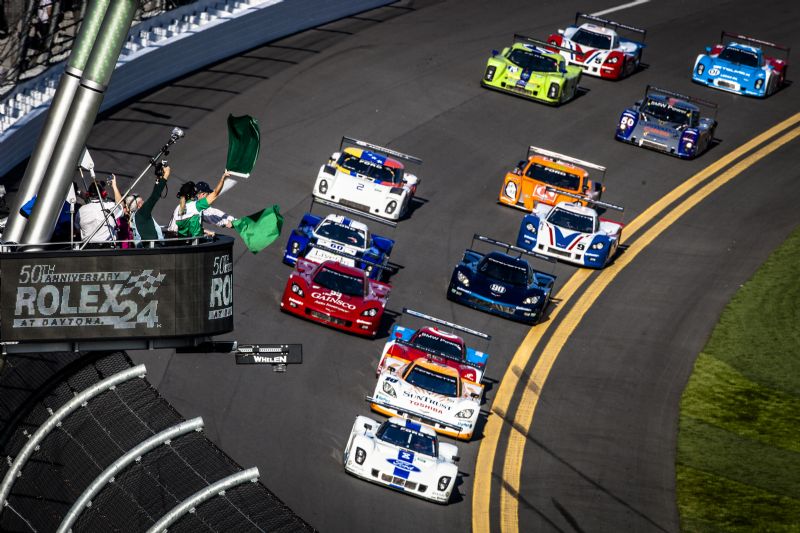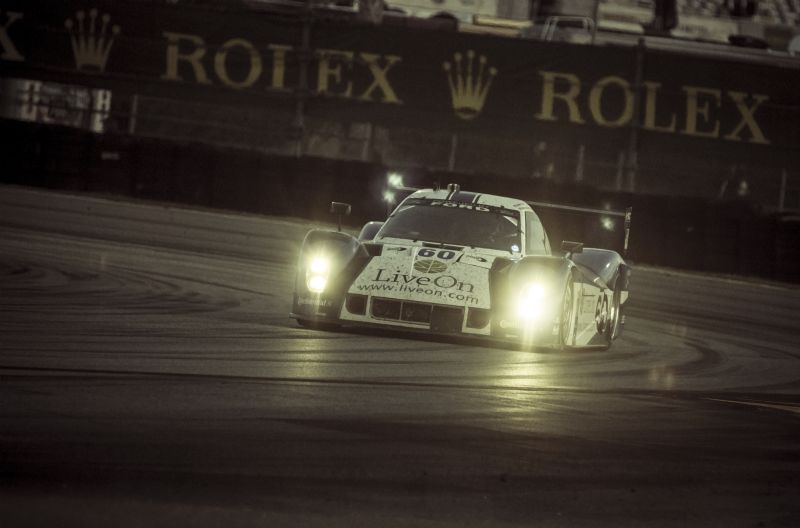Rolex 24 at Daytona Preview
 |
| The start |
With sunset just before 18:00 and sunrise close to 07:15 the following day at this time of year in Florida, night is a serious component of the Rolex 24 at Daytona. With the race start at 15:30 EST on Saturday, when the sun crests the eastern horizon of Daytona Beach on the Sunday morning the drivers will have spent over three-quarters of their race to that point in the dark. A third of the total race time is still to be run.
In the words of David Donahue, a previous winner in the GT class at both the 24 hours of Le Mans and here: “You have to enjoy the night to race at Daytona."
Darkness is a relative term at the Rolex 24 at Daytona. The race is driven entirely within the Daytona International Speedway, and benefits from close to 2000 lighting fixtures around the circuit. These are run at 20% during the night, and Jeff Hazell, a former racing team manager who has tasted success at Le Mans, makes the point that, in essence, the night presents drivers with similar problems to the day: “They need to focus on braking points, a corner’s turning in point, its apex, and the exit clipping point. They need to watch for oil, gravel and debris. Hands follow eyes, even at night."
Maximizing racing time
There is common consensus among all teams that the most significant, but hardest aspect of the night is to avoid making a mistake, getting hit, or running over something on the track. “In a 24-hour race it is not so critical to be the fastest car, it is important to spend the least amount of time in pit row," says Mike Colucci, a 37 year veteran of Daytona and team manager of Donahue’s Napleton Racing entry. This may be easier said than done.
As the Saturday night draws on, and most people are going to bed, the drivers and pit crews face a long stretch without the luxury of uninterrupted sleep to keep mind and body sharp. The race start may in the afternoon, but most team personnel have been up since the early morning preparing the cars. By the middle of the night fatigue has firmly set in, as Michael Shank the principal of Michael Shank Racing, which won the 2012 race overall, explains: “We work about 38 hours straight. Right before it gets light bodies can be slumping. Typically this is when bad things happen, just because of the tiredness. We do whatever we can to keep people alert."
Driver’s view
 |
| Last year's winning No. 60 Shank Racing Ford races into the night |
For the drivers the night session has to be approached as just another period in the race. “We are not allowed to choose what time we drive," explains Alex Gurney, winner of the 2007 and 2009 GRAND-AM Rolex Sports Car Series Daytona Prototype drivers' championship and son of American motor racing legend Dan Gurney. A driver in the Bob Stallings Racing team, Gurney says all drivers just accept the darkness as part of the game, even if it presents added difficulties: “At night, when you are in the race car you have a lot of lights coming from different directions, oil on the windshield, debris all over the track, and sight lines are closed in. You don’t have the same vision, so you have to have a heightened sense of awareness."
Donahue also points to reduced vision as one of the biggest challenges, especially deciphering what is a stationary light and what is a light of a car: “There are so many lights around the track and in the paddock that they can get caught in your mirrors. At least on the banking it gets nice and dark in the car. The rear view mirrors look into the pavement; if there are lights you know it’s a car."
Drop zone
The onset of night also leads to a drop in temperature during the hours of darkness, which has a significant impact. In some respects it can help, according to Hazell: “The cooler temperature can mean more power from the engine, and may allow a softer tire with more grip. Fastest lap times are often posted at night." John Fogarty, one of Hurley’s co-drivers, points out that: “[Night] affects the balance of the car pretty quickly, but there are only so many adjustments you can make in the timeframe of a pitstop."
Some drivers relish the night hours; there can be a surreal feeling of being in a cocoon. Mike Rockenfeller, the German driver in the Action Express Racing team and winner at the Rolex 24 at Daytona in 2010 finds he is in his element: “It is a special atmosphere, it is like being alone in a tunnel. If the car is going well it is a really enjoyable part of endurance racing." He does admit that in between stints at the wheel: “It can be difficult when it’s cold and you’d rather stay somewhere warm. But you have to get on with it and you soon get back in the groove."
Time management
Managing the minds and bodies of the drivers is part of the science of endurance racing. They benefit from a rotation system: the opportunity to remove themselves from the noise and activity surrounding the racetrack. This is particularly helpful during the night hours. At the Rolex 24 at Daytona, standard practice is to race with four drivers – one in the car, one ‘on deck’ in the pit and the remaining two usually resting in a motor-home located within the circuit, but away from the distractions of the pit lane.
Ron Barnaba, principal of Napleton Racing, explains how the rotation helps keep drivers as close to peak readiness as possible: “We have one person to take care of the drivers to make sure they can sleep, rest, eat, and hydrate. We don’t want them thinking of anything but the race." Even if a driver struggles to fall asleep, Hazell says that evidence suggests just lying still is 70% effective. Fogarty finds: “The ability to rest between stints changes each year. Some years it seems pretty easy, and you feel rested. Other years, say, if it is colder or there’s rain, it can wear you out."
For some drivers greatest problem at night is finding the discipline to take themselves away from the pits to switch off. As veteran racer Dario Franchitti once commented: “It’s a catch-22 situation. I want to watch the race, because it’s exciting – I’m a race fan and I want to see what’s happening. On the other hand I’ve got to distance myself and focus on my job."
The pits
The night world of the pit crew is wholly different matter, whether in a top Prototype team or in a smaller GT or GX team. Shank says matter-of-factly that even if he had the budget he would struggle to find sufficient skilled crew to rotate them. Colucci takes the point further: “In total, here we have almost twice the number of people we would have for a 6-hour race. Even so, the technicians have to stay up all night." It is a commonly held view that despite the fatigue the pit crews would have it no other way. There is a professional pride in their work and a desire to see the complete race through to its finish whatever it takes.
With cars pitting every 45 – 50 minutes, the technicians are kept busy and remain at their post throughout the night. Often, if they manage to find a moment for a powernap the car has to come in for an unscheduled stop. “They are on it all the time," says Colucci.
Hard experience helps managers prepare their troops for the long night hours at the Rolex 24 at Daytona. To keep his crew focused on the task at hand, Shanks is not opposed to catnapping, but says: “They keep their headphones on." Colucci and Barnaba install a couple of “surprisingly comfortable" zero-gravity lounge chairs in the pit box. Yet, while driver nutrition and rest patterns are planned carefully, there is no special training for the crews. “It’s hard to practice the exhaustion," laughs Colucci.
Night masters
From a driver’s perspective, the night component at a 24-hour race is something you may never get completely comfortable with, however many years of experience you have. According to Rockenfeller: “It doesn’t matter how many times you drive 24 hours it never gets easier, except perhaps knowing what to expect."
For the team managers knowing what to expect appears to make that critical difference between success and failure. Shanks has a ‘bible’ recording his notes from years of running teams, and before each Rolex 24 at Daytona emphasizes to his team: “If we follow this path, and the car stays in one piece, we will get a podium at this race." Last year alone was proof of his philosophy.
Colucci, whose first introduction to 24 hour racing as a mechanic back in 1975 ended in success, draws on his considerable experience to avoid the night component becoming an issue: “Treat it like any other race. Make sure that the car is bulletproof, that mechanical pieces do not fail, that bits do not fall off or wires separate and make sure people stay focused."
